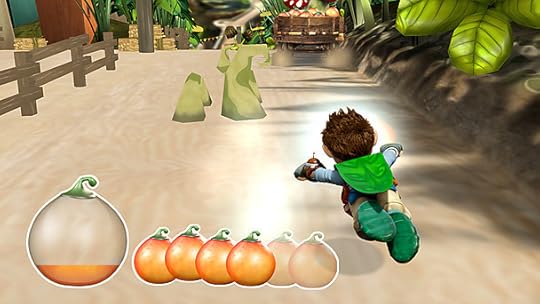The CBeebies Playtime App
CBeebies Playtime, a mobile app for Android, iOS, and Kindle Fire devices has launched. It’s designed for our audience of young
children and their families, enabling them to play games featuring much loved
CBeebies brands - anytime and anywhere.
The way children consume content is changing, as Joe Godwin,
Director of BBC Children’s, explains here
with tablets and smartphones becoming increasingly important. That’s why we’re
introducing our first Children’s app, offering our audience a safe and trusted
environment for handheld devices, free from marketing and paid for updates,
that enables children to learn through play alongside their favourite CBeebies
characters.
My colleague Lizzie Leadbeater has written about the app’s
features over on the CBeebies grown-ups blog and I’d like to
share some insight into how we built the app.

CBeebies Playtime Hub
Our aim was to create an app that was high quality, yet
simple enough for even the youngest children to use, and to incorporate all the
things children love about CBeebies; silliness, action, humour and excitement.
But above all else, it needed to inspire creativity and imagination whilst
being educationally beneficial.
CBeebies covers the 0 to 6 year old age range and within
this, children have many development milestones. For example, a two year old
has totally different requirements for learning and entertainment than a 6 year
old, so we needed to produce content that could be enjoyed by all kids and
their parents – something the CBeebies channel has excelled at over the years.
We’ve taken that same approach with Playtime, providing an interactive
experience that all of our audience can enjoy whilst applying the CBeebies
philosophy of 'leaning through play'.
Developing for multiple devices
As many of you know, developing apps for different platforms
and ecosystems is a costly and time-consuming process and as a publicly funded
organisation we have a responsibility to reach as many of our audiences as
possible, in the most cost-effective way. That’s why the initial platforms we
are targeting at launch are Android, iOS and Kindle Fire.
These platforms represent a myriad of different devices
being used in family households across the nation, and developing an
application natively for each device type would also require a huge amount of
resources from developers, designers, producers, project managers and testers.
Our solution was to build one core application based on a
single code base that we could optimise for the required devices. It gave us
the ability to efficiently build very high quality experiences, utilising the
native features of the devices where possible and making the most of their
visual display and audio playback capabilities.
As mentioned, the spread of devices on our target operating
systems is huge. Within this spread there is a large difference in performance,
available memory and screen sizes. It was necessary to make sure the devices
had an optimised asset set that allowed the application to render the graphics
as smoothly as possible, and use only an appropriate amount of memory to do so.
The graphics also had to work in screen size ratios that
varied from squat rectangle to letter box. To accommodate this we implemented a
system of button placement that relates to percentages rather than absolute
positioning. This allows the Playtime app to scale and adapt position to even
the most extreme screen real estate environments.
CBeebies Playtime has been developed so that extra features
and games can be added in seamlessly across all these devices as well, allowing
us to introduce new content and keep the app fresh.

Setting up a user profile
Making the app safe for a dual audience
The basic shape of the proposition is an engaging and
easy-to-use hub based around the idea of a CBeebies world populated by the
famous yellow bugs. The hub provides simple access to high quality branded
games for children, and a grown-ups section giving information about the
application's features, describes the games and their learning benefits, and is
home to the 'Give a Special Message' section.
This is an area that allows parents or carers to choose for
a special message to be delivered to their child - a "Well done" for
being really good today, "Happy Birthday", or even to record a
personal message. The message rewards are delivered the next time a child goes
to the hub. As CBeebies is a dual audience experience where child and
parent/carer engage together, the message reward system is a way of enabling
shared moments.
It is essential that the Playtime app is as safe as possible
for children to play in – like a walled garden that protects children by restricting
access to inappropriate content on the wider internet. To achieve this, all
user journeys that lead out of the app were placed in the grown-ups section,
which is behind a safety feature that requires relatively advanced cognitive
skills.
This section features information for each game, which links
out for more detail on the CBeebies Grown-ups website. Other routes out include
the terms and conditions, privacy statement and extra information – these
destinations are all hosted on the BBC website.
To prevent children from leaving the app, should they click
on any of these links, a number code will need to be entered into a keypad. The
number code is in word form but is entered via numbers, which forms a second
barrier to prevent little hands from straying too far, and has proved highly
effective in user testing.
Implementing learning benefits
The brands included in the app allow for great entertainment
and learning possibilities, which was a major priority for us when developing
the games.
Tree Fu Tom is a massively popular CBeebies brand that has
been exported to numerous countries around the world, and won many awards. Big
World Magic in Tree Fu Tom the TV show incorporates carefully selected
sequences of movement put together by movement specialists and designed to help
children develop important foundation motor skills.
This has been adapted for the touch screen in
"Chuckleberry Chase". Before each game users are invited to tilt
their device (or use their finger) to perform the Big World Magic and thus
enable 'Super Speed'. In the game, the Mushas (protagonists) have stolen all of
the Chuckleberries. To save the Harvest Festival Tom has to fly after them
collecting as many berries as he can while avoiding various obstacles.
The control method, as with the magic scene, is either tilt
or touch. The methods sit alongside each other being interpreted by the device
meaning there are no extraneous options that detract from the user experience.
The use of the controls will help children develop movement skills and fine
motor control at a crucial time in their growth.

Tree Fu Tom saving the harvest festival in Chuckleberry Chase
The Alphablocks are 26 living letters who discover that when
they hold hands and make a word, it comes to life. The series is based on
best-practise phonics as taught in schools. The Alphablocks game 'Word Magic'
is aimed to help young children develop confidence with reading and writing.
The child is invited to spell a word described in a picture. The controls are
either ‘tap to select’ the next letter - which is placed on the pedestal, or
the letters can be dragged and dropped. Spell the word correctly and the scene
explodes into life.
Octonauts is an internationally famous animated series
following the exploits of a team of adventurers, led by Captain Barnacle, who
live in an undersea base. Octonauts 'Cadet Training' is an opportunity for the
user to come and join the team. The game is aimed at helping children develop
an understanding of team-work and to learn more about the world around them,
via a number of missions are in the game - to rescue, save or help different
sea creatures.
To begin each mission Captain Barnacle issues commands that
the player (the cadet) must follow - fail and the submarine (the GUP-A) won't
stay on course. On reaching the destination native features of devices are used
to help complete the mission. The microphone is needed as the Orca whale must
be called for, the trapped hermit crab must have rocks shaken off him and the
touch screen needs to be used in helping a mother lobster collect her offspring
and also at the turtle cleaning station.
Something Special has been a jewel in CBeebies crown for
many years, featuring the hugely popular Mr Tumble and the Tumble family. The
simple format of the show is very inclusive and it is that premise that is
applied to the 'Paint Pop' game. The Tumble family each have an item of
clothing that needs decorating - the game is to pop bubbles so the splashes
colour the items.
A series of Something Special games on the CBeebies website
have iterated our knowledge of inclusive gaming and best practise. Here in
Paint Pop we have included settings that are customisable by a parent or carer.
The input methods can be tapping of the touch screen, switch control or noise
control via microphone. Other settings allow for simplification of the
gameplay, audio playback and button display.

Inclusive gaming with Something Special Paint Pop
The building of the app was a fully collaborative process,
involving a BBC team comprising of an editorial producer, product manager,
project manager, user experience lead, testers and researchers, all working
very closely with development agency Mobile Pie.
It was built in an agile manner based on user focussed
design. User testing was carried out throughout the project lifecycle with the
results feeding back into the development iterations. This really helped us to
make informed adjustments to the build, the user journeys and the game designs.
With technology now firmly embedded in children's lives it
creates amazing new opportunities to develop digital services for them. This
allows us to find new ways of informing, educating and entertaining a
generation of tech-savvy children in a safe environment that parents can trust.
We think we’ve struck the right balance with this app and
we’d love to hear your feedback in the comments.
Jon Howard,
Executive Product Manager, Children’s Future Media.
BBC's Blog
- BBC's profile
- 28 followers



